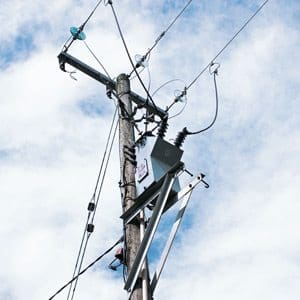Overhead

With electric wires being strung at the tops of poles to keep them out of the reach of the general public, it is obvious that transformers would be hung on the same poles, as close as possible to the high-voltage source conductors. Larger units are often placed on overhead platforms in alleyways, or alongside buildings, or on ground-level pads protected by fencing.
Overhead construction is still the most economical choice in rural areas, but it has the disadvantage of susceptibility to ice and wind storms.
The public no longer perceives overhead wiring as a sign of progress, instead considering it an eyesore that should be eliminated from view.
Underground

Larger cities with concentrated commercial loads and tall buildings have had underground primary cables and transformers installed in below-grade ventilated vaults since the early part of the 20th century.
By connecting many transformers into a secondary network, service to highly concentrated loads can be maintained even though a single transformer may fail. In a network, temporary overloads can be shared among all the connected transformers. The use of underground distribution for light industrial and commercial and residential service became popular in the 1960s, with the emphasis on beautification that promoted fences around scrap yards and the elimination of overhead electric and telephone lines.
The most common construction method for residential electric services is underground primary cables feeding a transformer placed on a pad at ground level. The problems of heat dissipation and corrosion are only slightly more severe than overheads, but they are substantially reduced compared with transformers confined in below-grade ventilated vaults.
Since pad mounts are intended to be placed in locations that are frequented by the general public, the operating utility has to be concerned about security of the locked cabinet covering the primary and secondary connections to the transformer.
The industry has established standards for security against unauthorized entry and vandalism of the cabinet and for locking provisions (ANSI/NEMA, 1999). Another concern is the minimization of sharp corners or edges that may be hazardous to children at play, and that also has been addressed by standards.
The fact that pad-mounted transformers can operate with surface temperatures near the boiling point of water is a further concern that is voiced from time to time. One argument used to minimize the danger of burns is to point out that it is no more hazardous to touch a hot transformer than it is to touch the hood of an automobile on a sunny day. From a scientific standpoint, research has shown that people will pull away after touching a hot object in a much shorter time than it takes to sustain a burn injury. The point above which persons might be burned is about 150˚C (Hayman, 1973).
Directly Buried
Through the years, attempts have been made to place distribution transformers directly in the ground without a means of ventilation. A directly buried installation may be desirable because it is completely out of sight and cannot be damaged by windstorms, trucks and automobiles, or lawn mowers.
There are three major challenges when directly buried installations are considered: the limited operational accessibility, a corrosive environment, and the challenge of dissipating heat from the transformer.

The overall experience has been that heat from a buried transformer tends to dry out earth that surrounds it, causing the earth to shrink and create gaps in the heat-conduction paths to the ambient soil. If a site is found that is always moist, then heat conduction may be assured, but corrosion of the tank or of cable shields is still a major concern.
Within the last several years, advances in encapsulation materials and techniques have fostered development of a solid-insulation distribution transformer that can be installed in a ventilated vault or directly buried using thermal backfill materials while maintaining loadability comparable with overhead or pad-mounted transformers.











THE POWER COMPANY JUST PUT A NEW TRANSFORMER IN OUR YARD, TWO FEET FROM HIS HOME AND EIGHT FEET FROM MY BEDROOM WINDOW/HOME, TWO FEET FROM MY SIDEWALK… THIS TRANSFORMER SERVICES FIVE HOMES…IS THEIR A THREE METER DISTANCE RULE THAT IS NEED FROM TRANSFORMER TO A DWELLING
The pad-mounted transformer behind my house has been buried into the soil by the people constructing a new building in the site behind my house. Only the top of the transformer is visible. Is this allowed?
I have a pole on the boundary of our property however this line carries a 11kv and therefore would need a 15kv transformer to be moulded on the pole. Is this a simple or complex project – there is a low voltage a few 100m from property / which step would be easier ?
I have a transformer on my property that converts the voltage for the entire neighborhood to house current. I am told it is a buried transformer. The housing above it is not warm to the touch. I have a pacemaker. How much electromagnetic radiation does the transformer emit? Is it safe for me to be around it? For what distance does the em radiation extend?